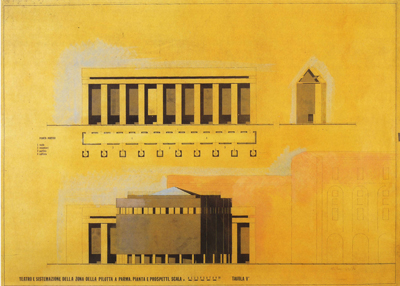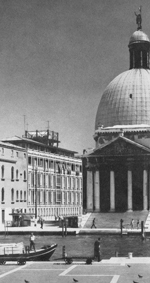You are in: Home page > Magazine > Redesigning Cities
Redesigning Cities
The Compact City Project

Enrico Prandi

A. Rossi, Project of Teatro Paganini, Parma 1964
Architecture as a discipline in a constant relationship with the world (cultural, social, economic, and so forth) is subject to the changes that occur therein. Occasionally these changes are so spread out over time that they are not immediately perceptible except through long historiographical reconstructions. Equally, occasionally they are so sudden as to impose decisive and sometimes also unthinkable changes of direction in thinking and architectural and urban research. This implies, as an indirect consequence, a selection of theoretical/practical questions and a return, anything but negative, to the very essence of Architecture.
Thus in a short time, both public and specialist opinion seems to have reached such a degree of maturity as to make possible a debate on themes which were absolutely unthinkable until a few years ago. In Italy in recent years, after dealing with the general theme of sustainability, of building upwards within the major problem of the standardization of architecture; after dealing more with the urban transformation of large suburban areas than with the architecture of the city as a whole, here we are returning overwhelmingly ‒ stripped of any taboo (or almost) ‒ to the theme of compact city architecture.
Nowadays building in historic centres, as well as resonating like a moral imperative that pacifies any fancifulness in the consumption of land, thereby appearing a sustainable practice, even seems possible.
Even because what is often found in these cases of revolutionary thinking is a conflict between different times: the dynamic time of the crisis and change in conditions that demands prompt actions, and that virtually static time of bureaucracy, of norms and regulations (of rules and of standardization).
Anyone currently wishing to prompt the densification of a historic centre would end up clashing with a normative apparatus heavily behind the times which, at a planning/forecasting level, still senses the effect of the falsely positivist mindset of the end of the last century. In fact, until just a few years ago, there was the recurrent belief, or it was preferred to believe (in good faith), that the city could continue its by and large spontaneous and indiscriminate expansion towards the countryside without a justifiable overall logic either of form or content, omitting the first skirmishes of change, omitting or distorting (in good faith) concrete data (economic, demographic, etc.). It was thought that cities were destined for unlimited growth, but above all that the theme, in the meantime transmuting into a problem, of the form of the city did not exist, or that it was by this time uncontrollable, ergo pointless tackling.
Those who, like the undersigned, continued to talk in those years about the form of the city, as well as morphology and typology, ended up being accused of anachronism, of cultural backwardness, of being (happily, I must add) “out of fashion”. All of this while international architecture was tackling, with fairly questionable results, the themes of the new cities in the Far East that were undergoing rapid demographic expansion, of luxury smart cities, of the non-stop competition to win new prizes for shape and size. This, perilously exceeding the threshold of the figurative load of Mies’ glass skyscraper, the Utopian load of Wright’s mile-high skyscraper, and the theoretical load of Loos’ Chicago Tribune skyscraper, only to end up circumscribed by a single typological example.
In this condition it is not sufficient to limit the damage by freezing the situation. We need the courage to do more.
The model of degrowth currently enjoying favour reported recently by Serge Latouche is generally acceptable, just as it is possible to imagine a derivative applied to the city, Urban degrowth, which involves rationalizing use through specific interventions (architectural, constructional, recovery and transformation but also new building), that may also be managerial in order to obtain a balanced ratio between city and countryside. Naturally, to be able to operate with the most complete awareness, it is opportune to design the degrowth of the city through an all-embracing approach that takes into account both functionality and the overall form.
Without any preconception, the recovery and transformation of the city also passes through the recovery and transformation of its territory in which, where deemed necessary, also inverse transformations must be made through re-planning actions that may even include the demolition of conspicuous parts. A process as courageous as it is revolutionary which the Emilia Romagna Region as part of its legislative autonomy has transformed into an operational tool (R. L. 16/2002 Norms for the recovery of historical/artistic buildings and the promotion of architectural and landscape quality in the region) albeit applied in the rarest of cases. This law envisaged interventions to eliminate incongruous works defined as “constructions and the results of interventions of transformation of the region which, in terms of visual impact, plani/volumetric dimensions or typological and functional characteristics, have permanently altered the historical, cultural or landscape identity of places” initiated through restoration projects and renewal interventions for the landscape. Even if not expressly indicated, it can be inferred that this norm should also include as a privileged field of application the landscape between one city and another, that of urban sprawl and suburban conurbation.
What is necessary today, just a decade after the R. L. 16, is a set of regulations that contemplate a more flexible possibility for interventions above all in areas considered historiographically saturated but which in today’s conditions have further potential to be used strategically, starting from central or temporary gaps, which, while disputes between conservationists and innovators raged on, became definitive. To this should be added a decisive resizing of the concept of the inviolability of the historic centre
“Building within the built” or intervening in the compact city must today be an occasion to return to a discussion of some of the themes of Italian tradition such as the relationship between architecture and environmental pre-existences[1], a certain propensity to build cities by means of plans created according to the architectural works[2] and the consideration of city architecture in its totality[3] and in its (formally completed) parts[4]: i.e. reconsidering the city as an “architecture of architectures”[5].
Only now are we discovering that we have lost ground by fighting a rearguard action in defence of the most important values of Italian architectural tradition. Unfortunately, however, we have had to wait for the new maestros, “our” maestros, namely the exponents of the generation born around the 1930s, to disappear one by one - first Aldo Rossi, then Gianugo Polesello, Carlo Aymonino and finally Guido Canella - to recover a theoretical apparatus which has given so much, but which above all still has much to give to Italian architecture. But not only.
1) The problem of building in historic centres was the theme which after the Second World War in Italy catalyzed the interest of international debate thanks to circulation of the magazine Casabella directed by E.N. Rogers. At the same time, at the Venice School under Giuseppe Samonŕ the theory of town-planning/architectural unity was forming, put into practice by Samonŕ himself in the Palermo Plans and in the more extensive district plans (e.g. the one for Trentino) while in that of the young Venetians of the Architecture Group (above all Polesello and Semerani) in the Plans for Pesaro and Trieste an “architectural” approach to the plan was attempted, which ran parallel to the birth of urban science.
[1] Rogers Ernesto N., The problem of building in environmental pre-existences, a report presented to the I.N.U. Study Commission in preparation for the VI National Town-planning Convention, now to be found in Esperienza dell’architettura, Einaudi, Turin 1959.
[2] Gianugo Polesello, Designing the City as Architecture and Plan, in L’Architettura Italiana Oggi. (The tale of a generation), edited by G. Ciucci, Laterza, Bari 1988.
[3] Aldo Rossi, City Architecture, Marsilio, Padua 1966.
[4] Carlo Aymonino, The Meaning of the City, Laterza, Bari 1976.
[5] Guido Canella, An Architecture of Architectures, in Lotus no. 7, 1970.

G. Samonŕ, INAIL headquarters, Venice 1950-56














